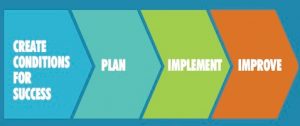Ed-Tech Product Implementation in Schools Critical to Success
 One of the most important things I’ve learned after two years in the K-12 product space (and trust me, there have been many lessons): Implementation of an ed-tech tool is key.
One of the most important things I’ve learned after two years in the K-12 product space (and trust me, there have been many lessons): Implementation of an ed-tech tool is key.
If you want schools to successfully adopt your product, you must have a well-crafted, thoughtful implementation strategy.
The discussion at a recent EdSurge summit in Oakland, Calif., really drove this point home. I was attending the summit with other ed-tech startups and school district leaders. My fellow entrepreneurs and I were there to learn how districts use technology, which tools they use, and how they decide what to buy. I had many productive one-on-one conversations with district administrators about Listenwise. I also heard the district perspective on implementation.
Administrators are swamped with initiatives at the beginning of the year—and often the district administrator who paid for the subscription isn’t the one implementing it. That means implementation isn’t always straightforward. If you don’t provide enough support, adoption will be weak.
One panelist, Rosanna Mucetti, the assistant superintendent of educational services at the San Leandro Unified School District, told us to use “systematic implementation” rather than a one-time training session. Mucetti said if implementation isn’t done well, your tool won’t make it into students’ hands—no matter how transformative it is.
She’s got a good point. I decided to adopt this approach toward implementation for fall for Listenwise, my ed-tech start-up.
I call it the “extreme implementation” project. Maybe I’ve been watching too much American Ninja Warrior this summer, but I want to push our team to go above and beyond the typical implementation model. I want our teachers to feel extremely supported.
My team expanded new subscribing school training from one webinar to a focused week of multiple implementation interactions, including our webinar. Teachers become more confident about using the tool, then they try it with their students and share it with their peers. This implementation week includes periodic emails about use case studies and links to recently published stories.
Another district leader, Cheryl Jordan of Milpitas Unified School District, advised the summit attendees to implement with fidelity and think mindfully about what we are doing. This means teachers need to be loyal to their ed-tech tools, give them a chance to work in their classrooms. We have to “build trust” and show how our tools help in everyday routines.
Administrators need to remember that if they buy a subscription to a new ed-tech tool, it doesn’t necessarily mean the teachers are eager to use it. And ed-tech companies like ours need to be systematic about how we introduce our tool to teachers, gain their trust, and eventually earn their continual use.
Implementation is an important step in the process that can’t be phoned in or rushed. If done right, you gain devoted users—and hopefully a smooth renewal. If done poorly, you risk the account.
Our extreme implementation strategy is working. More teachers are incorporating Listenwise into their lessons, and faster. More teachers are using it. Looks like watching all those American Warrior Ninja episodes paid off.
See also:
- Data Analytics Can Dive Startups in the Right Direction
- Chasing Renewals: When Your Buyer and User Are not the Same
- How Startups Can Become Social Media Influencers

ALL educators must be represented initially and throughout the process; from the initial identification of the problem, to setting of the goal, to establishing a benchmark, to researching solution options, to reviewing solution options, to choosing a solution provider, to beta testing that option…buy in needs to be established from the beginning and throughout